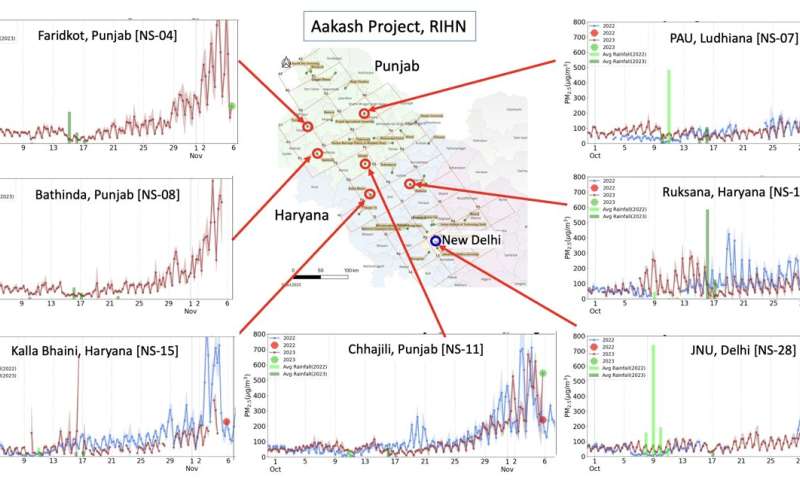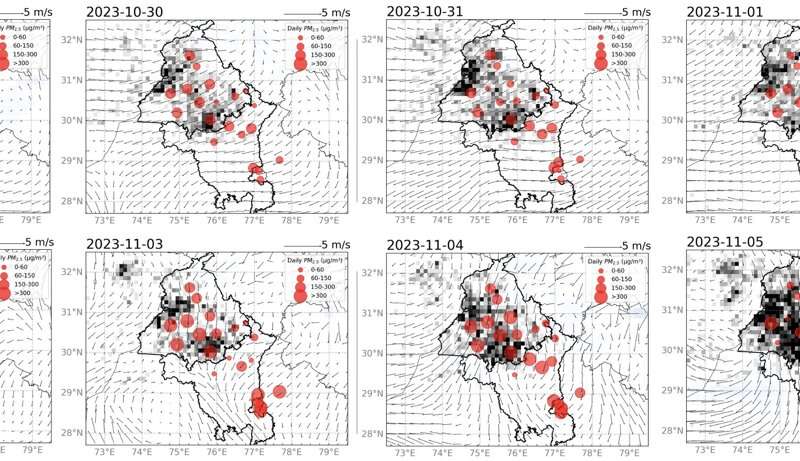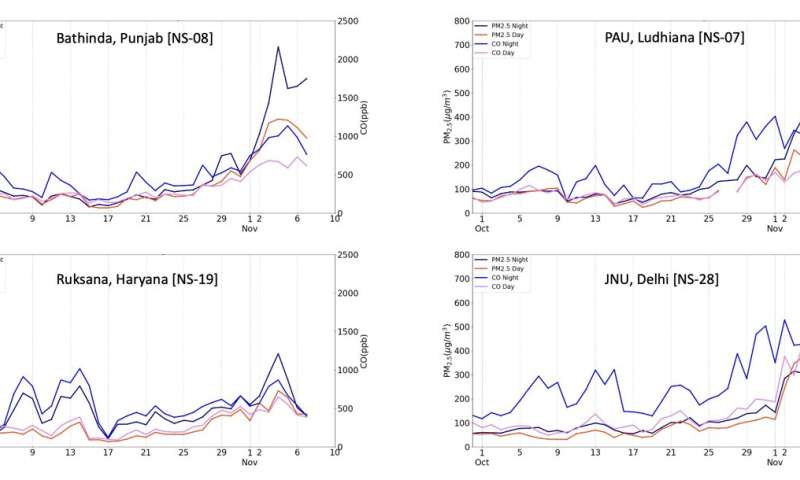Very high air pollution event in Delhi couldn't be explained by crop residue burning

While cricket world cup games are waiting to be played in Delhi stadiums, celebration of goddess Durga's defense of demon attack is just finished, festival of lights Diwali is just around the corner, but various activities in the Delhi National Capital Region (NCR) were restricted to protect residents from exposure to air pollution, i.e., particulate matter less than 2.5 µm in diameter (PM2.5).
This is not for first time and will not be for the last as well until the policymakers work in harmony, based on scientific evidences, to limit direct emissions of air pollutants.
Since the late October this year we can find how many crop residue burning (CRB) hotspots are detected in Punjab and Haryana, how the farmers are being tracked for their activities by the law-and-order departments. Tens of newspapers in English language alone are covering the daily updates on the situation on crop residue burning in the neighboring states of Haryana and Punjab.
But none have raised a question whether the CRB in Punjab is single most important cause of overall increase in air pollution through the month of October 2023 or in the earlier years, and the eventual closure of Delhi NCR on 2nd Nov 2023.
In 2022, a group of international collaborators led by the Research Institute for Humanity and Nature (RIHN) team have conducted field campaign in the region of Punjab, Haryana and Delhi NCR (Singh et al., 2023; RIHN press release on 2nd Oct 2023). A network of about 30 low-cost Compact and Useful PM2.5 Instrument with Gas sensors (CUPI-Gs) has been established in the region for this year as well.

These measurements, for the first time, provided a wholesome picture of month-long CRB activities in the source regions and their contribution to the limited number of high PM2.5 events over the Delhi NCR. In the air pollution events that occurred in Delhi last November, the impact of CRB was found to be severe. Our analysis also suggested its predictive capability by using the data from the whole CUPI-G measurements (Singh et al., 2023; unpublished analysis).
In response to recent reports suggesting that farming practices such as crop residue burning are the primary cause of air pollution in New Delhi, scientists in Japan and India are today setting the record straight. Their research and analysis shows conclusively that blaming farmers for the city's air pollution crisis is not only misleading but also unjust.
The data show that the real culprit is local emissions of Delhi NCR itself, which coupled with the recent adverse weather, has led to recent spikes in levels of PM2.5. The FLEXPART model simulation (Takigawa et al., 2020), representing fire emission tracer from the Visible Infrared Imaging Radiometer Suite (VIIRS) fire detections, shows the transport of airmass were limited to the source regions of Punjab and Haryana, and transported to the southern and western area more frequently than to the Delhi NCR.
Our analysis shows contrasting behavior in two markers for CRB, carbon monoxide (CO) and PM2.5. These pollutants have evolved quite differently in recent days as shown at 4 selected sites, with both PM2.5 and CO increasing rapidly on 2 Nov 2023 at Jawaharlal Nehru University (JNU) and other sites in Delhi NCR, but values increased much more slowly in the source region in Punjab and Haryana.

What does this mean? Firstly, that CO and PM2.5 levels must be coming from common sources—their behavior can't be explained through a single phenomenon such as crop residue fires, but local burning related sources must have large contributions (e.g., Mishra et al., 2023). Secondly, the behavior of the background levels points to a local source of pollution, pollution that is trapped nearby and not blown away/in on the winds.
Delhi NCR has in fact experiencing the consequences of their own local emissions. The weather pattern traps the air over Delhi NCR and prevents its dispersal. This build-up has led to the current crisis.
When we think about air pollution in Delhi NCR, it's wrong to hurry to judgment. Sometimes the real causes behind this emergency are industrial emissions, vehicular pollution, urban construction and developments and other urban factors that often go unchecked (e.g., Sawlani et al., 2018). As a community, we must address all causes of air pollution and not abjugate agricultural community only.
Aakash Project at the Research Institute for Humanity and Nature (RIHN), Japan is working closely with Indian counterparts to address the issue of "An Interdisciplinary Study toward Clean Air, Public Health and Sustainable Agriculture: The Case of Crop Residue Burning in North India". The article is prepared with inputs from Paul Griffiths of Cambridge University (visiting scientist at JAMSTEC), who is not a member of Aakash project, and we acknowledge his contribution.
More information:
The second report is available at https://www.chikyu.ac.jp/rihn_e/news/detail/414/
Provided by Research Institute for Humanity and Nature